Sarah L. Johnson's Blog, page 54
February 14, 2019
The Song Peddler of the Pont Neuf by Laura Lebow, a mystery of 1788 Paris
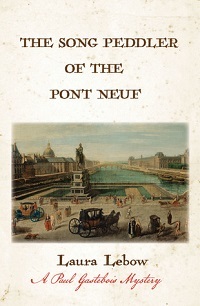 Paul Gastebois, a “confidential inquirer” in Paris of 1788, usually avoids taking on missing person cases. “People in Paris are lost all the time, sometimes on purpose,” he says. Still, he can’t resist the challenge of finding Gaspard Bricon, an elderly man who spent his days singing and selling copies of his songs on the Pont Neuf, the city’s oldest bridge.
Paul Gastebois, a “confidential inquirer” in Paris of 1788, usually avoids taking on missing person cases. “People in Paris are lost all the time, sometimes on purpose,” he says. Still, he can’t resist the challenge of finding Gaspard Bricon, an elderly man who spent his days singing and selling copies of his songs on the Pont Neuf, the city’s oldest bridge.One of Gaspard’s good friends is worried, and Paul feels touched by his concern. Besides, Paul’s well-paying gig of tailing a rich young Austrian diplomat around Paris for the police is pretty dull, and this new case fires up his curiosity. His search takes him to Gaspard’s lodgings, where a piece of crumpled parchment leads him to assume the song peddler was involved in high-level political blackmail.
The author’s skillful plotting keeps readers guessing as the mystery expands and transforms during Paul’s investigations through many Parisian neighborhoods. Our detective’s background is equally interesting; his younger sister Aimée is an apprentice seamstress, his brother is a churchman, and Paul had evaded his late father’s plans for him to join the butcher’s trade, preferring a career independent of the guilds (and smelly animal carcasses).
Lebow sets her series opener not in the popular French Revolutionary era but the less familiar time beforehand, and she incorporates the details to good effect. Louis XVI has agreed to convene the Estates General for the first time in over 170 years, and the commoners—who have grown more numerous and prosperous—place their hopes in finance minister Jacques Necker for fair representation and tax reform. Despite some people’s guarded optimism, there’s a fierce underground trade in scurrilous pamphlets, and Paul gets enmeshed in learning more about that risky business, too. Multifaceted characters, abundant local color, and dashes of wit (one of Paul’s disguises is laugh-out-loud funny) add to the appeal of this diverting mystery.
The Song Peddler of the Pont Neuf was published by Settocento Press in 2018; I reviewed it for February's Historical Novels Review. Fortunately, it appears to be first in a new series. The author's debut novel, The Figaro Murders, also stands out for its well-depicted original setting of 1780s Vienna.
Published on February 14, 2019 06:22
February 11, 2019
A gallery of forthcoming 2019 historical novels set before the 20th century
What I've been finding lately: new historical novels set earlier than the 20th century are getting to be rare beasts. WWII (and to a lesser degree, WWI) is still trending, and fiction evoking the 1950s and '60s is blossoming, too. One advantage of 20th-century settings is that they can seem modern enough to hook in contemporary fiction readers, thus reaching a wide audience beyond the historical fiction crowd. But what about readers who enjoy, even prefer, an earlier time frame? This post is for you.
Here are ten upcoming historical releases, with US publication dates in the first half of 2019, and set at least 119 years in the past. (Also note: small press and indie novels do a great job of covering pre-20th century eras. As in past years, I'll be doing a special focus on them in March.)
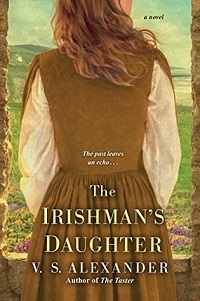
A young woman and her farming family face hardship during Ireland's Great Hunger in 1845 County Mayo. Kensington, Feb 26th. [see on Goodreads]
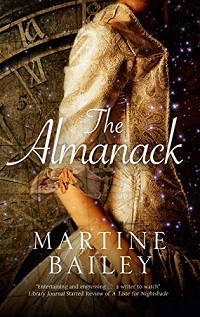
In looking into the mystery of her mother's drowning death, a young woman in 18th-century England discovers curious notes she'd left in her almanack. Severn House, May. [see on Goodreads]
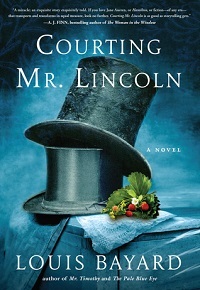
A literary portrait of the young Abraham Lincoln in Springfield, Illinois, in the 1840s, seen through the eyes of his future wife, Mary Todd, and his best friend, Joshua Speed. Algonquin, April. [see on Goodreads]
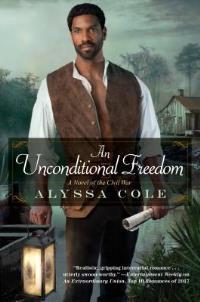
The third book in Cole's award-winning Loyal League series follows a newly freed Black man, an enterprising young woman, and their dangerous lives as covert spies for the Union during the Civil War. Kensington, February 29. [see on Goodreads]

Mary Ballard, a lady's maid to wealthy Charlotte Walden in 1820s New York City, holds many secrets, including her Irish heritage and her secret passion for her mistress. Atria, March. [see on Goodreads]
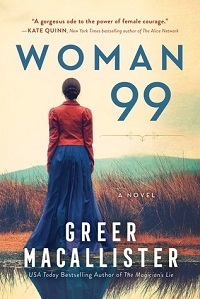
A young woman in late 19th-century San Francisco goes undercover in an insane asylum to rescue her sister, who their parents had unjustly placed there. Sourcebooks, March. [see on Goodreads]

Heading further back in time, Kate Mosse's newest epic, set in mid-16th-century France during its religious wars, opens as a young woman receives a mysterious note. Minotaur, June. [see on Goodreads]
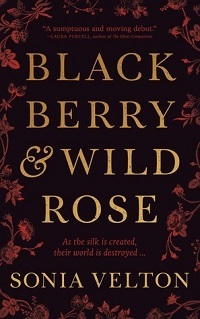
This debut features two ambitious young women in the Spitalfields district of mid-18th-century London, where Huguenot silk-weavers ply their trade and seek to perfect their designs. Blackstone, May. [see on Goodreads]
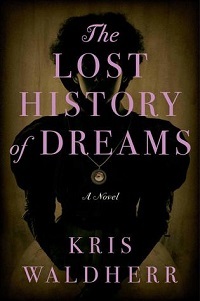
A Victorian gothic mystery set in the world of post-mortem photography, romantic poetry, ghosts, and lost love. Atria, April. [see on Goodreads]
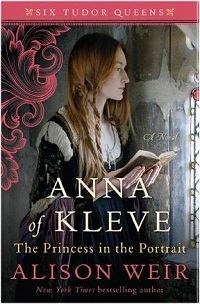
A new look at Henry VIII's fourth queen, and the newest in Weir's Six Tudor Queens series; the title refers to her as she would have called herself. Ballantine, May. [see on Goodreads]
Here are ten upcoming historical releases, with US publication dates in the first half of 2019, and set at least 119 years in the past. (Also note: small press and indie novels do a great job of covering pre-20th century eras. As in past years, I'll be doing a special focus on them in March.)

A young woman and her farming family face hardship during Ireland's Great Hunger in 1845 County Mayo. Kensington, Feb 26th. [see on Goodreads]

In looking into the mystery of her mother's drowning death, a young woman in 18th-century England discovers curious notes she'd left in her almanack. Severn House, May. [see on Goodreads]

A literary portrait of the young Abraham Lincoln in Springfield, Illinois, in the 1840s, seen through the eyes of his future wife, Mary Todd, and his best friend, Joshua Speed. Algonquin, April. [see on Goodreads]

The third book in Cole's award-winning Loyal League series follows a newly freed Black man, an enterprising young woman, and their dangerous lives as covert spies for the Union during the Civil War. Kensington, February 29. [see on Goodreads]

Mary Ballard, a lady's maid to wealthy Charlotte Walden in 1820s New York City, holds many secrets, including her Irish heritage and her secret passion for her mistress. Atria, March. [see on Goodreads]

A young woman in late 19th-century San Francisco goes undercover in an insane asylum to rescue her sister, who their parents had unjustly placed there. Sourcebooks, March. [see on Goodreads]

Heading further back in time, Kate Mosse's newest epic, set in mid-16th-century France during its religious wars, opens as a young woman receives a mysterious note. Minotaur, June. [see on Goodreads]

This debut features two ambitious young women in the Spitalfields district of mid-18th-century London, where Huguenot silk-weavers ply their trade and seek to perfect their designs. Blackstone, May. [see on Goodreads]

A Victorian gothic mystery set in the world of post-mortem photography, romantic poetry, ghosts, and lost love. Atria, April. [see on Goodreads]

A new look at Henry VIII's fourth queen, and the newest in Weir's Six Tudor Queens series; the title refers to her as she would have called herself. Ballantine, May. [see on Goodreads]
Published on February 11, 2019 16:00
February 8, 2019
The Valentine House by Emma Henderson, an Alpine family saga set in 20th-century France
 The Valentine house, a wooden chalet overlooking the valley of Hext in the French Alps, is given the Greek name “Arete” (meaning excellence or virtue) by its owner, Sir Anthony Valentine, who built it in the 19th century. Sir Anthony loves the classics, and he also loves the Haute-Savoie region with a near-erotic passion evoked in his private journals. He and his large family travel to Arete to spend their summers, and local farmers greet their British eccentricities with a mix of fascination and resentment.
The Valentine house, a wooden chalet overlooking the valley of Hext in the French Alps, is given the Greek name “Arete” (meaning excellence or virtue) by its owner, Sir Anthony Valentine, who built it in the 19th century. Sir Anthony loves the classics, and he also loves the Haute-Savoie region with a near-erotic passion evoked in his private journals. He and his large family travel to Arete to spend their summers, and local farmers greet their British eccentricities with a mix of fascination and resentment. Their exploits are recounted through the eyes of a French teenager, Mathilde, who becomes a servant at Arete in 1914. A bright peasant girl, her narrative voice is sharp and self-aware. She knows she owes her position to her unattractiveness – Sir Anthony’s wife only hires “uglies,” supposedly to deter his wandering eye – but Mathilde cares “not a jot.”
She’s a delight to spend time with, as she observes the Valentines, befriending their granddaughter, Daisy, and accompanying them on hikes. During her duties, she comes upon a peculiar love letter whose impact she doesn’t recognize until six decades later.
The chapters set in 1976, told in the third person from the viewpoint of George, Daisy’s grandson, lack the liveliness of the earlier sections, but Mathilde carries the story there also. Now a stubborn widow in her seventies, she faces a tough decision. American developers seek a foothold in the region, and Mathilde’s son, Luc, takes their side – but Mathilde holds a secret that may deter his plan. The two timelines eventually join.
The family saga aspect is entertaining, if somewhat drawn out, but it’s a treat to spend time in this remote, beautiful area of France. Mathilde is a great character, and Francophiles will applaud when she cheekily carves a circumflex (arête means “sharp mountain ridge”) into the Valentine house’s written name.
The Valentine House was published by Sceptre (UK) in 2018; I reviewed it for the Historical Novels Review from a personal copy. I bought it purely based on the historical setting, which turned out to be a good choice.
Published on February 08, 2019 05:00
February 4, 2019
The Hundred Wells of Salaga examines women's lives and internal slavery in late 19th-c Ghana
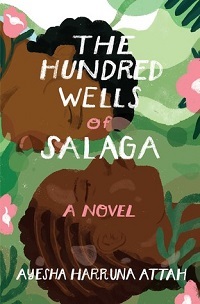 Told with the poetic simplicity of a folk tale, but with the rich detail and scope of an epic, The Hundred Wells of Salaga is a memorable read about a little-known historical subject: indigenous slavery in pre-colonial Ghana, and how it affected the lives of two young women and their families. The lives of Aminah, a teenager from the village of Botu, and Wurche, the only daughter of a lesser chief of Kpembe, begin worlds and many miles apart, but their stories come together midway through.
Told with the poetic simplicity of a folk tale, but with the rich detail and scope of an epic, The Hundred Wells of Salaga is a memorable read about a little-known historical subject: indigenous slavery in pre-colonial Ghana, and how it affected the lives of two young women and their families. The lives of Aminah, a teenager from the village of Botu, and Wurche, the only daughter of a lesser chief of Kpembe, begin worlds and many miles apart, but their stories come together midway through. Both heroines are proud and resilient, qualities that carry them through considerable personal turmoil. Aminah, who had used to spend her time daydreaming, selling maasa (millet porridge) to people on the caravan when it passed through Botu, and caring for her younger twin sisters, is taken captive by horsemen along with her siblings and forced to march far from home.
Although she’s part of the Gonja royal family and is accordingly self-assured, Wurche also experiences a loss of freedom after she agrees to marry a prince of Dagbon to seal an alliance. After Wurche’s father sees an opening to seize power for himself, infighting among the Gonja people further destabilizes the twin towns of Kpembe and Salaga, which had already been thrown into chaos due to the disruption of the local kola nut trade.
In the late 19th century, Salaga, as we learn, is a center for intra-African trade of all kinds, including that of human beings. The novel’s title alludes to this fact; the water from Salaga’s many wells was used to wash the many slaves brought there for sale. In a Q&A at the end, Attah reveals that her great-great-grandmother had been enslaved and sold at the market at Salaga, but little else is known about her. Aminah’s story is the author’s imagined version of her life, while details about royal women such as Wurche are better documented.
Their journeys are recounted in a direct manner, without cliché or stereotype, and the secondary characters are well-rounded also. These include Moro, a slave-trader who seeks a way out of the terrible business, and Helmut, a sympathetic German man. The novel also includes insightful detail on the land’s spoken languages, foods, and religions, including how Islam (which Wurche’s family observes) can be used to establish both order and control over women’s lives.
The novel is just 230 pages long, but it has the heft of a work of much greater length. I recommend it for its insight, smooth readability, and its power of bringing an important aspect of the history of the slave trade to light in fiction.
The Hundred Wells of Salaga is published tomorrow in the US by Other Press, with the beautiful cover art above; it was previously published in Nigeria by Cassava Republic. Thanks to the publisher for sending me an ARC at my request.
Published on February 04, 2019 17:00
January 30, 2019
Historical fiction award winners from ALA Midwinter 2019
 Greetings from the frozen Midwest!
Greetings from the frozen Midwest!On Sunday and Monday, a number of literary awards were announced at the American Library Association's Midwinter conference in Seattle. Although I wasn't in attendance, I was following along as best I could on Twitter.
Here are the historical novels that were honored at the conference (and please let me know if I've missed any). Links go to the ALA press releases. I had reviewed some of them, too, and will link to the reviews where applicable.
On the 2019 Reading List , which selects the best in genre fiction for adult readers:
In the Historical Fiction category, the winner was Amanda Skenandore's Between Earth and Sky (Kensington), which focuses on a woman, her childhood friendship with a Native American man, and the forced assimilation taking place at Indian boarding schools in the late 19th century.
On the shortlist for Historical Fiction were:
The Butcher’s Daughter, by Victoria Glendinning, set in Tudor England;
Circe by Madeline Miller, a retelling of the Greek myth;
Dear Mrs. Bird, by AJ Pearce, about a young woman who becomes an advice columnist in wartime London; and
A Well Behaved Woman: A Novel of the Vanderbilts, by Therese Anne Fowler, about Alva Vanderbilt.
In the category of Horror, the winner was The Silent Companions by Laura Purcell, a creepy and unusual haunted house story set in 1860s England.
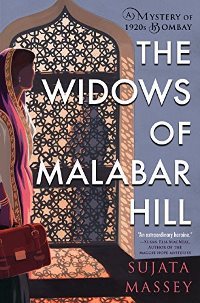 In Mystery, The Widows of Malabar Hill by Sujata Massey, a mystery about the first woman lawyer practicing in 1920s Bombay, was the category winner.
In Mystery, The Widows of Malabar Hill by Sujata Massey, a mystery about the first woman lawyer practicing in 1920s Bombay, was the category winner.The winner of the 2019
On the 2018 ALA Notable Books list were two historical novels:
Esi Edugyan, Washington Black, about a young boy's flight from slavery; and
Michael Ondaatje, Warlight, literary fiction set after WWII.
Among the Alex Award winners, for adult fiction that appeal to teen readers, were Madeline Miller's Circe and Naomi Novik's historical fantasy Spinning Silver.
Both Newbery Honor books, geared toward young readers, were historical fiction:
Veera Hiranandani, The Night Diary, a middle-grade novel set during the Partition of India in 1947;
Catherine Gilbert Murdock, The Book of Boy, a medieval adventure novel.
... and the Margaret A. Edwards Award, for lifetime achievement in writing for young adults, went to M. T. Anderson, who has written many historical novels for that age group, including The Astonishing Life of Octavian Nothing.
Which ones have you read?
Published on January 30, 2019 05:00
January 29, 2019
A Love Letter to Houston: a guest post by Dawn Adams Cole, author of Drops of Cerulean
Dawn Adams Cole is stopping by today with an essay about the historical background to her new novel, Drops of Cerulean, which is published today. Set in Houston over seven decades in the 20th century and beyond, the novel is a family saga with a reincarnation theme.
~
"A Love Letter to Houston"Dawn Adams Cole
"A love letter to Houston” is how I describe my novel, Drops of Cerulean. And true to form as any good love letter, memories and a spirit of hope permeate the family saga that spans 1930-2014, highlighting the city as both the setting and a prominent character in its own right.
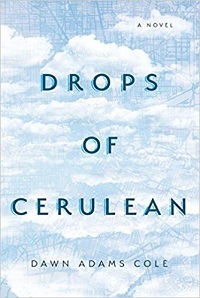 The 1930 start date served as an intentional nod to the city’s ethos. The Houston Metropolitan Research Center, an archival branch that focuses on the history of Houston and located in the Julia Ideson Building of the Houston Public Library, offered a wealth of resources, including newspaper articles, photographs, and letters relating to prominent city events. Although the novel begins in 1930 at the onset of the Great Depression, research confirmed Houston’s unique reaction to this tumultuous time. Before the crash, many Houstonians remained optimistic regarding their future, oil and the Port of Houston serving as indicators of the city’s resilience. Jesse Jones, prominent Houston businessman and philanthropist, brought together city leaders to ensure that no banks in Houston failed during the Great Depression. While the city was not unscathed from the financial crisis, the city was spared the full devastation.
The 1930 start date served as an intentional nod to the city’s ethos. The Houston Metropolitan Research Center, an archival branch that focuses on the history of Houston and located in the Julia Ideson Building of the Houston Public Library, offered a wealth of resources, including newspaper articles, photographs, and letters relating to prominent city events. Although the novel begins in 1930 at the onset of the Great Depression, research confirmed Houston’s unique reaction to this tumultuous time. Before the crash, many Houstonians remained optimistic regarding their future, oil and the Port of Houston serving as indicators of the city’s resilience. Jesse Jones, prominent Houston businessman and philanthropist, brought together city leaders to ensure that no banks in Houston failed during the Great Depression. While the city was not unscathed from the financial crisis, the city was spared the full devastation.
1930 marked the opening of the Merchants and Manufacturer’s Building, now known as the University of Houston Downtown, a building that helped inspire the narrative. Originally planned as a multi-use, commercial building, it welcomed retail, offices, suites, clubs, restaurants, and lounges. Located at the meeting of White Oak Bayou and Buffalo Bayou with railroads bordering the first floor of the building, the structure was amenable to rail and water commerce.
Records of the initial details are limited, but I found the original tenant list and real estate advertisements, which corroborated the aspirations for the building. I embraced the skeletal findings as an opportunity for creative freedom while keeping with the intended spirit – a place that embodied hopes and dreams of a generation, a place that failed in its original aspirations but experienced redemption, albeit decades later, as an educational institution. In this way, the building mirrors the reincarnated souls of the narrative in that it finds resolution and purpose in the next stage.
The Niels Esperson Building appealed to me from the time I was a child frequenting downtown, the bronze color and cupola marking it from its peers. Mrs. Mellie Esperson’s story of boldly erecting the building in her late husband’s name provided a sharp contrast to Ilona’s story as a reticent soul tethered to the memory of her disgraced late husband. While there are an abundance of supporting articles in the archives, a tour of the private building served as the highlight of my research. Jano Nixon Kelley, Director of Marketing for Cameron Management, graciously indulged the request, which included a tour of Mellie Esperson’s private office suite, the floor redesign belonging to an architectural firm, the floor that was intended to serve as a private apartment for Mrs. Esperson, and a vacated 2-floor law office on the top floors. The stories shared and the personal experience of the tour itself supported and enriched the family saga.
 author Dawn Adams ColeConfirming and learning more of the history of the city supported the lore and historical record of my family’s Houston roots, a history infused by the ethos of the city. My great-grandfather immigrated to Texas and founded a machine shop in East Houston in 1929, around the time Jesse Jones helped spare the city from full impact. Although I never met my great-grandfather, I grew up hearing stories of his work ethic and grit. I only knew the machine shop as its location a block from the interstate, but I recall my grandfather sharing his recollections of the time before the interstate when the streetcar ended in East Houston at Wayside. My family’s bold move to continue pursuing their dreams despite the times folded into the spirit of the Petrarkis and Doyle families, a sentiment not unusual for optimistic Houstonians of the time. Personally, this spirit struck a different chord from my paternal side of the family who were once well-to-do New Yorkers prior to the economic crash.
author Dawn Adams ColeConfirming and learning more of the history of the city supported the lore and historical record of my family’s Houston roots, a history infused by the ethos of the city. My great-grandfather immigrated to Texas and founded a machine shop in East Houston in 1929, around the time Jesse Jones helped spare the city from full impact. Although I never met my great-grandfather, I grew up hearing stories of his work ethic and grit. I only knew the machine shop as its location a block from the interstate, but I recall my grandfather sharing his recollections of the time before the interstate when the streetcar ended in East Houston at Wayside. My family’s bold move to continue pursuing their dreams despite the times folded into the spirit of the Petrarkis and Doyle families, a sentiment not unusual for optimistic Houstonians of the time. Personally, this spirit struck a different chord from my paternal side of the family who were once well-to-do New Yorkers prior to the economic crash.
The intentional starting point of 1930 anchored the timeline, and while I knew the general course, struggles, and sentiments of the characters, I enjoyed researching historical and cultural influences to compliment the story. The Flood of 1935 offered a striking setting for Cadmus’ birth, a narrative that lent itself to his father being an active part of the delivery, which was unusual for the time. Researching popular songs during the early '60s provided inspiration to Ilona’s reincarnation as Delphina, and I was pleased with the connection that the Broadway hit Cats debuted around the time Delphina received her First Communion, her struggle on committing to a faith she doubted accented the rebirth she intuitively sensed. Similarly, the James Turrell exhibit in 2013 created the symbolic context for Robert’s passing and supported the idea that there is no death.
While a part of me regards the cultural findings as serendipitous, I believe artistic pursuits mirror our innate, universal desire for hope and redemption. The search may take different forms in different times and different cultures, and perhaps there are periods when the drive is more pronounced. Connecting the dots between the cultural representations during the course of the narrative proved reaffirming and rewarding, and it fueled my belief in our interconnectedness.
In “Love Letters,” an article featured in the Saturday Evening Post, Nina Sankovitch states, “The qualities of a good letter are also the qualities of a good relationship. Letters are the tangible manifestation of the singularity of our kinship, the importance of our shared experiences…” If Sankovitch’s thesis is a litmus test, then I hope my novel fits the bill. I believe Drops of Cerulean embodies the historical ethos of Houston, with the memories and sentiments of the characters a reflection of what we, as humans, continue to experience.
~About the Novel:
Spanning the years 1930–2014, Drops of Cerulean (on-sale January 29, 2019; Greenleaf Book Group Press) chronicles the lives of Ilona, the daughter of a Greek restaurateur, who marries into a prominent Houston family; her son, Cadmus, who becomes a professor and then moves into a retirement home after his husband passes away; and Delphina, an anxiety-ridden woman with a mysterious recurring dream.
Ilona and Cadmus have a falling out when Cadmus is a young man, and before they are able to reconcile, Ilona dies. Cadmus is plagued with guilt and feels responsible for the death of his mother. Two worlds collide when, years later, Delphina comes to understand that she had been Ilona, Cadmus's mother, in her previous life.
Set in Houston and revolving around the city's ever-changing skyline, Drops of Cerulean is an amazing debut from a gifted writer.
About the Author:
Dawn Adams Cole was born and raised in Houston. She received her BA from the University of St. Thomas and her MEd from Harvard University. She lives in The Heights with her husband, Burton, and her daughters, Caroline and Elizabeth.
~
"A Love Letter to Houston"Dawn Adams Cole
"A love letter to Houston” is how I describe my novel, Drops of Cerulean. And true to form as any good love letter, memories and a spirit of hope permeate the family saga that spans 1930-2014, highlighting the city as both the setting and a prominent character in its own right.
 The 1930 start date served as an intentional nod to the city’s ethos. The Houston Metropolitan Research Center, an archival branch that focuses on the history of Houston and located in the Julia Ideson Building of the Houston Public Library, offered a wealth of resources, including newspaper articles, photographs, and letters relating to prominent city events. Although the novel begins in 1930 at the onset of the Great Depression, research confirmed Houston’s unique reaction to this tumultuous time. Before the crash, many Houstonians remained optimistic regarding their future, oil and the Port of Houston serving as indicators of the city’s resilience. Jesse Jones, prominent Houston businessman and philanthropist, brought together city leaders to ensure that no banks in Houston failed during the Great Depression. While the city was not unscathed from the financial crisis, the city was spared the full devastation.
The 1930 start date served as an intentional nod to the city’s ethos. The Houston Metropolitan Research Center, an archival branch that focuses on the history of Houston and located in the Julia Ideson Building of the Houston Public Library, offered a wealth of resources, including newspaper articles, photographs, and letters relating to prominent city events. Although the novel begins in 1930 at the onset of the Great Depression, research confirmed Houston’s unique reaction to this tumultuous time. Before the crash, many Houstonians remained optimistic regarding their future, oil and the Port of Houston serving as indicators of the city’s resilience. Jesse Jones, prominent Houston businessman and philanthropist, brought together city leaders to ensure that no banks in Houston failed during the Great Depression. While the city was not unscathed from the financial crisis, the city was spared the full devastation. 1930 marked the opening of the Merchants and Manufacturer’s Building, now known as the University of Houston Downtown, a building that helped inspire the narrative. Originally planned as a multi-use, commercial building, it welcomed retail, offices, suites, clubs, restaurants, and lounges. Located at the meeting of White Oak Bayou and Buffalo Bayou with railroads bordering the first floor of the building, the structure was amenable to rail and water commerce.
Records of the initial details are limited, but I found the original tenant list and real estate advertisements, which corroborated the aspirations for the building. I embraced the skeletal findings as an opportunity for creative freedom while keeping with the intended spirit – a place that embodied hopes and dreams of a generation, a place that failed in its original aspirations but experienced redemption, albeit decades later, as an educational institution. In this way, the building mirrors the reincarnated souls of the narrative in that it finds resolution and purpose in the next stage.
The Niels Esperson Building appealed to me from the time I was a child frequenting downtown, the bronze color and cupola marking it from its peers. Mrs. Mellie Esperson’s story of boldly erecting the building in her late husband’s name provided a sharp contrast to Ilona’s story as a reticent soul tethered to the memory of her disgraced late husband. While there are an abundance of supporting articles in the archives, a tour of the private building served as the highlight of my research. Jano Nixon Kelley, Director of Marketing for Cameron Management, graciously indulged the request, which included a tour of Mellie Esperson’s private office suite, the floor redesign belonging to an architectural firm, the floor that was intended to serve as a private apartment for Mrs. Esperson, and a vacated 2-floor law office on the top floors. The stories shared and the personal experience of the tour itself supported and enriched the family saga.
 author Dawn Adams ColeConfirming and learning more of the history of the city supported the lore and historical record of my family’s Houston roots, a history infused by the ethos of the city. My great-grandfather immigrated to Texas and founded a machine shop in East Houston in 1929, around the time Jesse Jones helped spare the city from full impact. Although I never met my great-grandfather, I grew up hearing stories of his work ethic and grit. I only knew the machine shop as its location a block from the interstate, but I recall my grandfather sharing his recollections of the time before the interstate when the streetcar ended in East Houston at Wayside. My family’s bold move to continue pursuing their dreams despite the times folded into the spirit of the Petrarkis and Doyle families, a sentiment not unusual for optimistic Houstonians of the time. Personally, this spirit struck a different chord from my paternal side of the family who were once well-to-do New Yorkers prior to the economic crash.
author Dawn Adams ColeConfirming and learning more of the history of the city supported the lore and historical record of my family’s Houston roots, a history infused by the ethos of the city. My great-grandfather immigrated to Texas and founded a machine shop in East Houston in 1929, around the time Jesse Jones helped spare the city from full impact. Although I never met my great-grandfather, I grew up hearing stories of his work ethic and grit. I only knew the machine shop as its location a block from the interstate, but I recall my grandfather sharing his recollections of the time before the interstate when the streetcar ended in East Houston at Wayside. My family’s bold move to continue pursuing their dreams despite the times folded into the spirit of the Petrarkis and Doyle families, a sentiment not unusual for optimistic Houstonians of the time. Personally, this spirit struck a different chord from my paternal side of the family who were once well-to-do New Yorkers prior to the economic crash. The intentional starting point of 1930 anchored the timeline, and while I knew the general course, struggles, and sentiments of the characters, I enjoyed researching historical and cultural influences to compliment the story. The Flood of 1935 offered a striking setting for Cadmus’ birth, a narrative that lent itself to his father being an active part of the delivery, which was unusual for the time. Researching popular songs during the early '60s provided inspiration to Ilona’s reincarnation as Delphina, and I was pleased with the connection that the Broadway hit Cats debuted around the time Delphina received her First Communion, her struggle on committing to a faith she doubted accented the rebirth she intuitively sensed. Similarly, the James Turrell exhibit in 2013 created the symbolic context for Robert’s passing and supported the idea that there is no death.
While a part of me regards the cultural findings as serendipitous, I believe artistic pursuits mirror our innate, universal desire for hope and redemption. The search may take different forms in different times and different cultures, and perhaps there are periods when the drive is more pronounced. Connecting the dots between the cultural representations during the course of the narrative proved reaffirming and rewarding, and it fueled my belief in our interconnectedness.
In “Love Letters,” an article featured in the Saturday Evening Post, Nina Sankovitch states, “The qualities of a good letter are also the qualities of a good relationship. Letters are the tangible manifestation of the singularity of our kinship, the importance of our shared experiences…” If Sankovitch’s thesis is a litmus test, then I hope my novel fits the bill. I believe Drops of Cerulean embodies the historical ethos of Houston, with the memories and sentiments of the characters a reflection of what we, as humans, continue to experience.
~About the Novel:
Spanning the years 1930–2014, Drops of Cerulean (on-sale January 29, 2019; Greenleaf Book Group Press) chronicles the lives of Ilona, the daughter of a Greek restaurateur, who marries into a prominent Houston family; her son, Cadmus, who becomes a professor and then moves into a retirement home after his husband passes away; and Delphina, an anxiety-ridden woman with a mysterious recurring dream.
Ilona and Cadmus have a falling out when Cadmus is a young man, and before they are able to reconcile, Ilona dies. Cadmus is plagued with guilt and feels responsible for the death of his mother. Two worlds collide when, years later, Delphina comes to understand that she had been Ilona, Cadmus's mother, in her previous life.
Set in Houston and revolving around the city's ever-changing skyline, Drops of Cerulean is an amazing debut from a gifted writer.
About the Author:
Dawn Adams Cole was born and raised in Houston. She received her BA from the University of St. Thomas and her MEd from Harvard University. She lives in The Heights with her husband, Burton, and her daughters, Caroline and Elizabeth.
Published on January 29, 2019 04:00
January 27, 2019
Alan Brennert's Daughter of Moloka'i, about the Japanese-American internment, and a companion to the bestselling Moloka'i
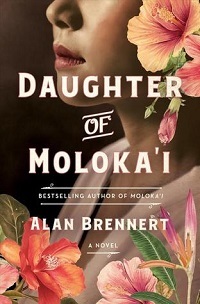 Brennert’s Moloka’i (2003), which followed the life of Rachel Kalama, a native Hawaiian sent to the Kalaupapa leper colony on Moloka’i as a child, became a bestseller and word-of-mouth book-club hit. Since then, fans have been clamoring for more about his realistic characters.
Brennert’s Moloka’i (2003), which followed the life of Rachel Kalama, a native Hawaiian sent to the Kalaupapa leper colony on Moloka’i as a child, became a bestseller and word-of-mouth book-club hit. Since then, fans have been clamoring for more about his realistic characters.His latest focuses on Ruth, the baby Rachel and her Japanese husband were forced to give up. More a companion novel than a sequel, Ruth’s story, beginning in 1917, is compellingly told and strikes all the right emotional notes.
Cherished by the Watanabes, the Japanese couple who adopts her, Ruth still feels like an outsider sometimes, due to her mixed heritage. Her sensitive, compassionate nature carries on into adulthood, making it easy to warm to her. After relocating to California, Ruth’s proud family faces internal turmoil and racial prejudice, and their forced internment in camps after Pearl Harbor is rendered in poignant detail.
Scenes of her reunion with Rachel and their blossoming relationship are immensely touching. A historically solid, ultimately hopeful novel about injustice, survival, and unbreakable family bonds. Expect high demand.
Daughter of Moloka'i will be published next month by St. Martin's Press, and I reviewed it (as above) for Booklist's Dec 1 issue. I had previously read Moloka'i, which happens to be a longtime favorite, but believe this novel will stand just fine if read on its own.
I often recommend Moloka'i to readers looking for novels that follow a single character through his/her entire life, and Daughter of Moloka'i works as an excellent companion to it, filling in gaps in the narrative related to Ruth's firsthand experience and the relationship between her and her birth mother after they're reunited. If you're a fan of Moloka'i, you'll want to read it!
Moloka'i is on sale for $2.99 on Kindle (US) over the next few days, for those who haven't read it yet.
Published on January 27, 2019 04:29
January 22, 2019
Interview with Clarissa Harwood, author of Bear No Malice, set in Edwardian England
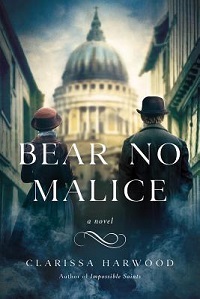 Clarissa Harwood's Bear No Malice is an entrancing historical novel set at the same time as her debut, Impossible Saints, but with the antagonist from that book, the arrogant Tom Cross, transformed into a hero -- and it works! Kidnapped away from London and badly beaten, Tom recuperates at the quiet Surrey cottage of his rescuers, siblings Miranda and Simon Thorne. They have taken up residence in this out-of-the-way locale for reasons having to do with secrets in Miranda's past. Tom, who has just broken off an affair with a married female parishioner, decides to keep his own identity secret from them, including his status as a canon of St. John's Cathedral. The story of Miranda and Tom's growing friendship is moving and unexpected, and the dilemmas they face aptly reflect their personalities and the social mores of the early 20th century. I'm grateful to Clarissa for answering my questions about her writing.
Clarissa Harwood's Bear No Malice is an entrancing historical novel set at the same time as her debut, Impossible Saints, but with the antagonist from that book, the arrogant Tom Cross, transformed into a hero -- and it works! Kidnapped away from London and badly beaten, Tom recuperates at the quiet Surrey cottage of his rescuers, siblings Miranda and Simon Thorne. They have taken up residence in this out-of-the-way locale for reasons having to do with secrets in Miranda's past. Tom, who has just broken off an affair with a married female parishioner, decides to keep his own identity secret from them, including his status as a canon of St. John's Cathedral. The story of Miranda and Tom's growing friendship is moving and unexpected, and the dilemmas they face aptly reflect their personalities and the social mores of the early 20th century. I'm grateful to Clarissa for answering my questions about her writing.Bear No Malice may be a companion novel to Impossible Saints, but for new readers, it does stand alone equally well. How challenging was this to accomplish?
When I first started writing Bear No Malice, I didn’t realize I was writing a companion novel: I thought I was just having fun with a writing exercise to see if I could turn Tom, the “villain” of Impossible Saints, into a hero. Or to put it another way, I was trying to view the conflicts between rival clergymen Paul and Tom from Tom’s point of view for a change. I didn’t realize the writing exercise would turn into a whole new novel! Although I always saw the two novels as connected, I worked on them at different times and treated them like separate novels, not thinking about the potential challenges that could arise should they both be published.
The real challenge came after Impossible Saints was published last year and I was working on revisions to Bear No Malice. Because two scenes are the same in both books (but told from different characters’ points of view), and they cover the same time period, I had to change the time frame of Bear No Malice. The biggest difficulty in this respect was having to change the seasons: the original opening chapters of Bear No Malice were set in rural England in the summer, and I had to change them to winter scenes. I nearly despaired when I realized that a gardening scene had to take place in late November, but after an intensive bout of research, I was saved by the hardy parsnip! As someone who hates gardening, I now know far more than I ever wanted to about vegetables that can be harvested in England in November!
This novel shows readers a different side to Tom Cross, the nemesis of Paul from Impossible Saints. I think he makes for a terrific hero! What new aspects of his character did you learn about during the writing?
Thank you! It took me ages to warm up to Tom because I’d thought of him as a villain for so long while inhabiting Paul’s point of view in Impossible Saints. I had to interview Tom many times and learn how to listen to him (to this day he is the only character in any of my novels who ended an interview abruptly by cursing me and walking out!). Many times I rued the day I cavalierly imagined an annoying colleague for Paul while writing the first draft of Impossible Saints without thinking that someday I might need to spend a great deal of time with that annoying colleague. Now I love both Paul and Tom equally: it’s as if they’re two squabbling sons of mine!
My first impression of Tom was of a womanizing, arrogant, domineering man, but as I got to know him better with each draft of the novel, I saw how complex he really was underneath his lies and masks, and his good qualities began to shine through: he’s a genuinely warm person, the best kind of extrovert who wants to help others. And yes, he is deeply flawed, but he’s also willing to learn and change.
What new research did you have to conduct for this novel? What was the most fascinating thing about the research process?
Some of the research was the same for both novels: I needed to know Church of England history as well as the history of penitentiaries, which figure prominently in both novels. (By penitentiaries, I’m referring not to prisons but to the charities first established in Victorian England to reform “fallen” women.)
New research for Bear No Malice with respect to Miranda, my female protagonist and artist, had me delving into the art world of Edwardian England. And without giving too many of Tom’s secrets away, I needed to research social reforms and reformers of the era. I learned about child labor, the slum areas of London, prison reform, and illegal boxing clubs. The most fascinating discovery I made was a real-life historical person, Osborne Jay, who was the perfect mentor for Tom and an important influence on Tom’s work at the end of the novel. This is not the first time I’ve imagined a character who would fit perfectly into my novel’s world, only to find in the course of my research that such a person really existed! What I love most about writing historical fiction is the way research and imagination trigger and feed off each other in an endless cycle.
As a historical novel heroine, Miranda is an original character: she’s reclusive, highly observant, and needs her solitude, and that’s on top of her difficult-to-overcome past. How did you develop her personality?
Some characters seem always to have existed in my mind and are just waiting for a story. Miranda is one of them. I always wanted to write about a Lady of Shalott figure who is isolated from the world because of a secret or curse in her past. Miranda was also an easy character to develop because I can relate to her personality very well. I can understand her better than Lilia (the suffragette protagonist of Impossible Saints) because she’s more conventional on the surface, whereas Lilia is always storming around doing things that scare me. I love Miranda’s quiet strength and stubbornness, and she’s just as much a feminist as Lilia in her own way. In the first stages of writing Bear No Malice, my biggest challenge with Miranda was trying to figure out what she saw in Tom, despite his obvious physical attractiveness. But even that was not so much a problem with Miranda as it was with my reluctance to really get to know and understand Tom.
Since both novels involve cathedral canons, I can’t resist asking: do you have a favorite English cathedral?
York Minster! No question. York is an amazing city, and the cathedral there has a beauty and ambience like no other. I could spend weeks wandering around inside it. St. Paul’s in London gets an honorable mention: I’ve visited it several times and especially love the whispering gallery. My first day visiting a new city always starts at the cathedral (if there is one), so if I had the time and money, and if my traveling companions didn’t object, my trips would be all cathedrals all the time!
Thanks very much, Clarissa!
~
Bear No Malice was published by Pegasus Books this month. For more information, visit the author's website at www.clarissaharwood.com.
Published on January 22, 2019 05:00
January 17, 2019
Espionage in full color: The Blue by Nancy Bilyeau, set in 18th-century England and France
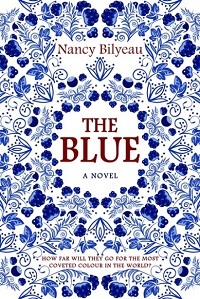 “… Color is the next field of battle in the porcelain wars. He who is able to produce the most porcelain in this new revolutionary color of blue will control the market.”
“… Color is the next field of battle in the porcelain wars. He who is able to produce the most porcelain in this new revolutionary color of blue will control the market.” As we learn in The Blue, the color blue surrounds us in the natural world – the sea and the sky, for example – but is surprisingly difficult to capture in physical form. The quest to create a chemically stable form of deep blue for use in art and textiles lasted for centuries. In the 1750s, when this story takes place, delicate porcelain creations are in great demand in high society. If porcelain designs could be painted with this new shade of blue, it would be a lucrative triumph for the firm to accomplish it first.
Nancy Bilyeau has taken a fascinating footnote from the annals of international commerce and transformed it into a captivating story of espionage, obsession, and love. A twenty-something resident of Spitalfields parish in late 1750s London, Genevieve Planché unexpectedly finds herself at the epicenter of the race to develop this elusive blue.
Genevieve is a woman of her time yet with enough feminine spunk to also give her viewpoint contemporary resonance. A descendant of French Huguenots who took refuge in England, she holds fast to her Protestant beliefs. She’s also a talented artist, but no one is willing to help her advance in her craft. Her late father’s cousin is a principal at the Derby Porcelain Works, but she fears that spending her days in the dreary act of painting porcelain would stifle her creativity.
However, an encounter with the debonair and sympathetic Sir Gabriel Courtenay creates a new opportunity: if Genevieve accepts the position at Derby, and secretly infiltrates the factory to discover the formula for blue from a chemist there, Sir Gabriel will help her establish an art career in distant Venice. Her employers are suspicious about possible French spies, but her mission proceeds as planned – until she meets the chemist himself, Thomas Sturbridge, who is the antithesis of the stodgy, self-absorbed scientist she expected.
Genevieve is a resourceful creation who proves capable of thinking with her head even when her heart is engaged. As the story twists and deepens, she must make tough decisions to ensure her safety. Along the way, readers experience the Huguenots’ delicate situation through her viewpoint. Even two centuries after the St. Bartholomew’s Day Massacre, the Huguenots have never forgotten the deadly persecution they faced. With England and France now engulfed in the Seven Years War, Genevieve – with her French name and heritage – must continually defend her loyalty to her birthplace of England, to her chagrin, and despite her revulsion for the French king.
Not only does The Blue cover fresh ground in a genre that often returns to the same well-trodden subjects, but it’s plain fun to read. Historical fiction readers are in for an exciting treat.
The Blue was published by Endeavour Quill in 2018; I read it from a personal purchase and coordinated the review to be published during the author's blog tour.
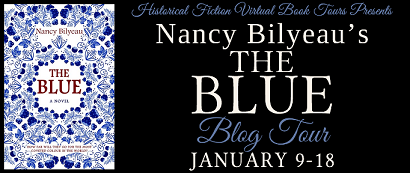
Giveaway: During the Blog Tour we will be giving away an eBook of The Blue by Nancy Bilyeau! To enter, please use the Gleam form below.
Giveaway Rules:
– Giveaway ends at 11:59pm EST on January 18th. You must be 18 or older to enter.
– Giveaway is open internationally.
– Only one entry per household. All giveaway entrants agree to be honest and not cheat the systems; any suspect of fraud is decided upon by blog/site owner and the sponsor, and entrants may be disqualified at our discretion.
– Winner has 48 hours to claim prize or new winner is chosen.
The Blue
Published on January 17, 2019 04:00
January 13, 2019
Historical fiction cover trend for 2019: bold colors that pop!
In putting together another visual preview post for 2019, I came upon some historical novel covers with bright colors and designs that refuse to be ignored. And then I found a few more. Here are ten, below. You can make almost a full rainbow with all of these. What do you think - does the effect work on you? Just the settings and the book's publishers are listed below... head on over to Goodreads for more.
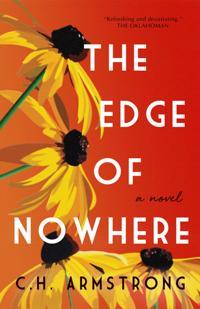
A family saga set during the Depression-era Dust Bowl. Central Avenue, June 2019. [see on Goodreads]
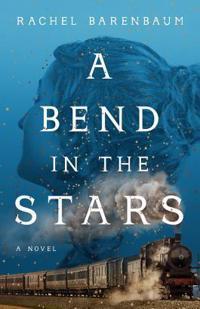
A scientific race across Russia in 1914, at the time of a major solar eclipse. Grand Central, May 2019. [see on Goodreads]
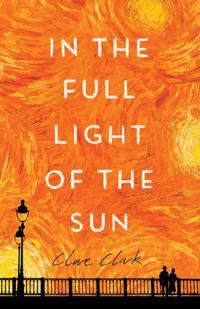
A controversial art scandal involving Van Gogh's paintings, set in decadent and dangerous 1920s Berlin. Houghton Mifflin Harcourt, July 2019. [see on Goodreads]
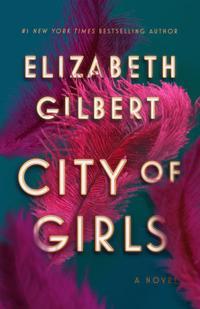
Glamour, passion, and coming of age in New York's exciting theater world in the 1940s. Riverhead, June 2019. [see on Goodreads]
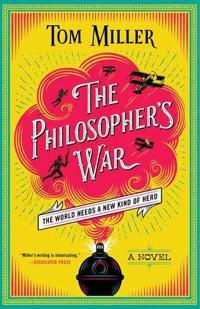
Historical fantasy involving aerial adventure in WWI France; second in a series. Simon & Schuster, July 2019. [see on Goodreads]
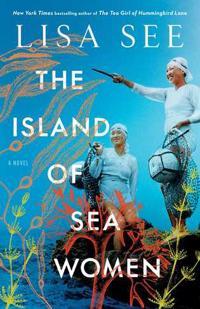
The female divers of the Korean island of Jeju, spanning from the 1930s through 1950s. Scribner, March 2019. [see on Goodreads]

Two American sisters' lives, from the 1950s going forward. June 2019, Atria. [see on Goodreads]
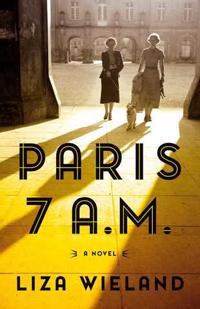
Events from the life of future poet Elizabeth Bishop, during her time in Paris in 1937. Simon & Schuster, June 2019. [see on Goodreads]
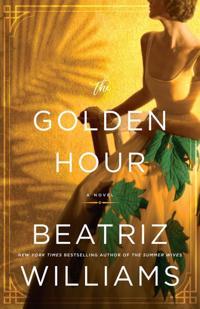
Espionage and scandal in the Bahamas in 1941, when the Duke and Duchess of Windsor are in residence there. William Morrow, July 2019. [see on Goodreads]
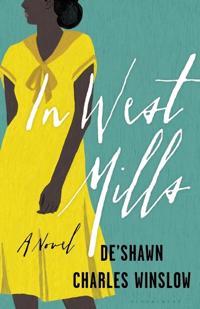
An independent African American woman in small-town North Carolina, between 1941 and the 1980s. Bloomsbury, June 2019. [see on Goodreads]

A family saga set during the Depression-era Dust Bowl. Central Avenue, June 2019. [see on Goodreads]

A scientific race across Russia in 1914, at the time of a major solar eclipse. Grand Central, May 2019. [see on Goodreads]

A controversial art scandal involving Van Gogh's paintings, set in decadent and dangerous 1920s Berlin. Houghton Mifflin Harcourt, July 2019. [see on Goodreads]

Glamour, passion, and coming of age in New York's exciting theater world in the 1940s. Riverhead, June 2019. [see on Goodreads]

Historical fantasy involving aerial adventure in WWI France; second in a series. Simon & Schuster, July 2019. [see on Goodreads]

The female divers of the Korean island of Jeju, spanning from the 1930s through 1950s. Scribner, March 2019. [see on Goodreads]

Two American sisters' lives, from the 1950s going forward. June 2019, Atria. [see on Goodreads]

Events from the life of future poet Elizabeth Bishop, during her time in Paris in 1937. Simon & Schuster, June 2019. [see on Goodreads]

Espionage and scandal in the Bahamas in 1941, when the Duke and Duchess of Windsor are in residence there. William Morrow, July 2019. [see on Goodreads]

An independent African American woman in small-town North Carolina, between 1941 and the 1980s. Bloomsbury, June 2019. [see on Goodreads]
Published on January 13, 2019 17:00



